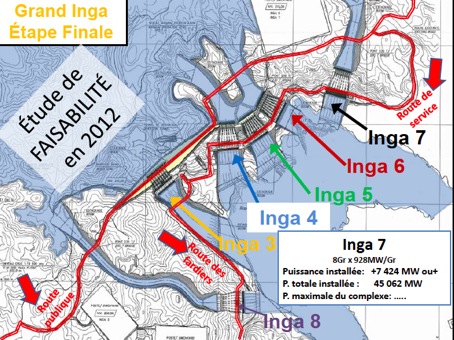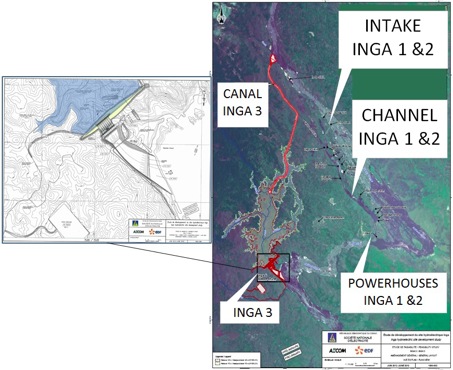The Democratic Republic of Congo’s (DRC) controversial Inga 3 hydroelectric project is not expected to begin producing power until 2024 or 2025, not 2020 or 2021 as originally planned. The project was announced in 2013 to great fanfare with World Bank support. at an estimated cost of $14 billion, supposed to deliver 4800 MW of power, primarily for export to South Africa and to power mines in eastern DRC. However, World Bank canceled support in 2016, throwing the project into disarray as investors have shied away. in part to address criticism of the project’s flawed economics, the govt announced in 2017 that it would redesign the project. as of early 2018. Recently the DRC asked for final bidders, one consortium led by China Three Gorges Corporation and another that includes Spain’s ACS (Actividades de Construccion y Servicios SA) to submit a joint bid according to Reuters.
Background
DRC has long pinned its hopes on the vast hydropower potential of the Inga Falls on the Congo River to serve as a battery for the region’s power needs. The Inga 3 Dam is the first phase of the ambitious Grand Inga hydropower scheme, whose generation capacity is estimated at 40,000MW.. However, the DRC’s ambitions for Inga to serve as the battery to meet the continent’s power needs have been beset by problems for decades.
The plan to build the Inga 3 hydropower scheme has been in the cards as far back as the early 1950s. Since that time, developers from several countries have expressed an interest in implementing the project. These have included French, Belgian, Chinese, Brazilian and African companies and investors. In 1972 and 1982, the Mobutu government of the Democratic Republic of Congo, then called Zaire, built the Inga 1 and 2 hydropower schemes, with a total potential generation capacity of 2,132MW. Sadly, these two schemes have never operated to full capacity; in 2013 the dams were reported to have produced only 40% of their capacity.
At the end of the civil war in the DRC and the peace deal of 2003, the country revived its plans to construct Inga 3. In 2004, the Western Power Corridor (Westcor), a consortium of national utilities from five southern and central African countries (Angola, Botswana, Namibia, South Africa and the Democratic Republic of Congo), organized and signed a Memorandum of Understanding with the DRC government to construct Inga 3, with its power to be distributed to all signatory countries through the Southern African Power Pool.
In 2009 the DRC withdrew from Westcor and decided to try to go it alone on the project. Its first step was to float tenders for the development of Inga 3 with private companies. The international mining corporation BHP Billiton won the tender, with its proposal to develop Inga 3 as well as a 2,000MW rated aluminum smelter in the vicinity of the hydropower plant.
When BHP Billiton withdrew from the deal in 2012, the DRC again began looking elsewhere. The World Bank and other financial institutions came on board in May 2013, promising to offer finance for Inga 3. As part of this deal, South Africa committed to buy 2,500MW of the 4,800MW to be generated. A treaty sealing this deal was concluded in October 2013 and ratified by the DRC in 2014, making South Africa the key purchaser of the Inga 3 electricity.
The new design was projected to cost US$14 billion and to generate 4,800MW when completed. The Grand Inga itself could eventually have a capacity of 40,000MW – equivalent to more than 20 large nuclear power stations. In addition to building the dam wall and Inga 3 hydropower plant by 2022, the project proposes a power line that would stretch more than 5,000km from the project to South Africa, through Zambia and Namibia. However, in September 2016 the World Bank cancelled its support to the Inga-3 due to the DRC government’s decision to take the project in a different strategic direction to that agreed between the bank and the DRC government in 2014.
Concerns about Inga 3
The development of this hydropower project raises a number of concerns. Firstly, the power production from the Inga 3 is mainly for industry users and will not improve the access level for the more than 90% of the DRC population who have no access to electricity. The prospect of local people getting power from Inga in the next 20 years is remote and does not feature in the project as currently planned. Most of Inga 3’s power will travel long distances to the industrial and urban centers in South Africa and large mines in DRC, by passing Congolese who are not served by the nation’s limited grid. Also with change of leadership and the signing of the agreements between government and 27 South African renewable energy independent power producers (IPPs). Will South Africa still require this energy.
The DRC has suffered decades of civil war, during which corruption has become entrenched in the socioeconomic fabric of the nation. By many accounts, the country has acquired a reputation as a failed state. It is sad to note that, in this vein, the Inga 3 stands to become a large-scale infrastructure of false ideals. People will have to be relocated and agricultural land in the Bundi Valley will be lost. The development model for the project does not appear to make any considerations to meet the expectations of the locals. On the contrary, the project will only add national debt burden, with very strong prospects of promoting corruption and allowing powerful companies to cheaply exploit and export Africa’s vast natural resources. Large volumes of research carried out worldwide have shown that grid-based electrification is not cost-effective for much of rural Sub-Saharan Africa where the population density is low. Renewable energy solutions such as wind, solar and micro hydropower projects are much more effective at reaching the rural poor.
The DRC government and the supporters of this dam need to critically examine their role in this project and to promote transparency and the pursuit of world standards in the development of these projects. There is need for transparency, sincere and committed public engagements and implementation of an energy development path that addresses the needs of the country.



